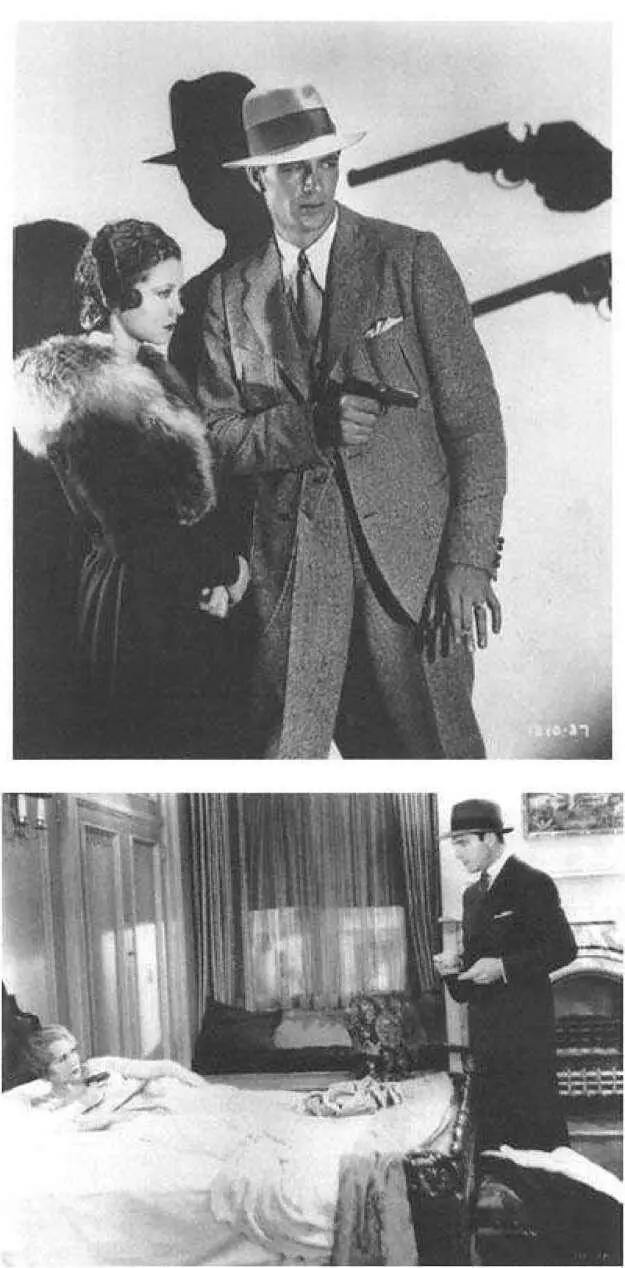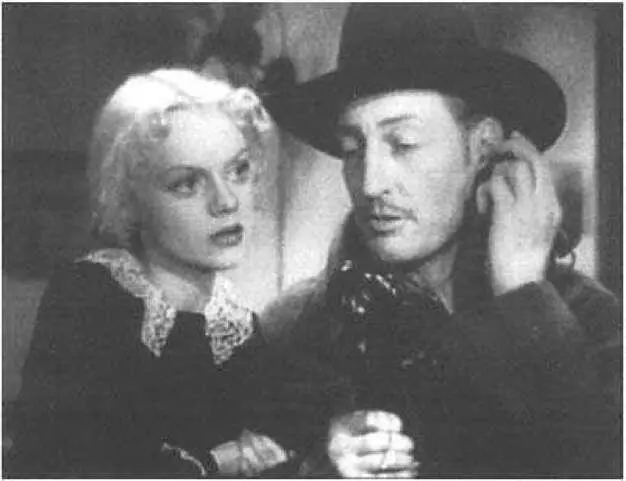That same year, Warner Brothers began its famous series of realistic gangster pictures, and alongside Little Caesar it produced a relatively faithful adaptation of The Maltese Falcon, starring Ricardo Cortez and Bebe Daniels. Because this version was shot in Warner's fastpaced, lowbudgeted, proletarian style, it sometimes feels more like pulp fiction than Hammett's original. Scriptwriter Brown Holmes preserved most of the novel's action and dialogue but none of its subtlety; at the end of the picture, we learn that Wilmer has killed off both Caspar Gutman and "Joe" Cairo and that Sam Spade has been rewarded with a political appointment as special investigator for the district attorney's office. Ricardo Cortez makes Spade seem like a ruthless opportunist, but it is difficult to say whether this effect is intended. The acting and direction are quite broad, and with the possible exception of Dwight Frye as Wilmer, none of the characters seem as decadent or perverse as the ones in the novel. Even Spade's womanizing is treated as little more than an opportunity for some cheerfully randy, pre-Code cheesecake.
In contrast, The Thin Man, Hammett's least characteristic novel, proved to be a gold mine. The 1934 MGM adaptation, scripted by Albert Hackett and Francis Goodrich, was turned into a sort of screwball detective story, which made good use of William Powell and Myrna Loy. Powell had played an elegant sleuth before, but he and Loy together created a refreshingly modern and risqué couple, offering Depression-era audiences an amusing fantasy of wealth, sexiness, and irresponsibility within marriage. The Thin Man was one of the top ten moneymakers of 1934, and it spawned five sequels between 1935 and 1947 (not counting a radio series of the 1930s, a TV series of the 1950s, a made-for-TV movie in 1977, and a Broadway musical in 1991). In each successive picture, Powell and Loy became increasingly domesticated. Their last effort, The Song of the Thin Man, was made in what is usually regarded as the peak year of American film noir: it features Gloria Grahame, it takes place in the world of New York jazz clubs, and one of its characters suffers from an "obsessive guilt complex"; nevertheless, it feels like a cross between an MGM musical and a TV sitcom (all the more so because young Dean Stockwell plays Nick Jr.).
The Thin Man led to a brief cycle of what The New York Times described as "hilarious homicide" pictures (15 June 1935), and the film created a virtual subgenre of married-couple detective stories. Thus, although the first version of The Maltese Falcon had not been a hit, there was now a resurgence of interest in Hammett. In response, Warner's remade Falcon in 1935 as a "hilarious homicide" movie entitled Satan Met a Lady, with Bette Davis as a wicked woman named Valerie Purvis and Warren William as a private eye named Ted Shane. The script was once again written by Brown Holmes, but this time the settings were plush and the action was spread across a broad landscape. Unfortunately, Satan Met a Lady is an almost painfully bad movie. Warren William bears a slight physical resemblance to Hammett, but he behaves like a fading and boorish Shakespearean actor in the mold of John Barrymore. Bette Davis is overweight and visibly uninterested in the proceedings, perhaps because the script is so absurd. Caspar Gutman becomes "Madame Barabas" (Alison Skipworth); Joel Cairo becomes "the tall Englishman" (Arthur Treacher); and the Falcon itself is transformed into "Roland's Trumpet,'' a medieval hunting horn stuffed with diamonds. Director William Dieterle attempts to create a farcical tone, but most of his efforts are shrill and clumsy. One of the few redeeming elements is the dumb-blond performance of young Marie Wilson (later to become famous in radio's My Friend Irma) as Shayne's secretary.
Also in 1935, Paramount filmed The Glass Key, a project it had considered as early as 1931 but had dropped because of Hays Office objections to any movie depicting corruption among "municipal and state office holders." 28The revised version, starring George Raft and Edward Arnold, was reminiscent of the Warner gangster cycle, but it avoided censorship problems by making "Ed" Beaumont a professional bodyguard rather than a gambler and by portraying Paul Madvig as a man who no longer has associations with the mob. Beaumont's seduction of the newspaper editor's wife was omitted altogether, and his beating at the hands of Jeff was depicted offscreen. (The Production Code Administration [PCA] demanded that Jeffs reference to Beaumont as a "massacrist" be dropped, and the studio complied.) The resulting picture was a competent if unoriginal thriller that became one of the top box-office hits of the 19361937 season.
At this point, Hammett's reputation as a literary artist was well established. (Falcon was translated into French in the mid 1930s, and it soon developed an international following.
It was also issued in a Modern Library edition in 1934.) Ironically, however, with the possible exception of The Thin Man, Hollywood had never made a film based on his work that was true to the spirit of what he had written or worthy of critical attention. Five more years would pass before John Huston, a scriptwriter who began his career by publishing Hemingwayesque stories in Mencken's American Mercury, chose a Hammett novel for his directorial debut at Warner Brothers. His 1941 version of The Maltese Falcon is widely regarded as the most faithful screen adaptation of Hammett, but it is also an innovative film that transforms its source, bestowing upon it an aura of modernist cinema that American reviewers immediately associated with Hitchcock and prewar France.


Three early films based on Dashiell Hammett: Gary Cooper and Sylvia Sydney in City Streets (1931), Ricardo Cortez and Beebe Daniels in The Maltese Falcon (1931), and Warren William and Marie Wilson in Satan Met a Lady (1935).
(Museum of Modern Art Stills Archive.)
Huston's screenplay involved little more than an intelligent editing of the novel, which is mostly dialogue anyway. He telescoped scenes, cut minor characters (including Caspar Gutman's daughter), and made slight changes to get past the censors. And yet, even though the words are mainly Hammett's, the film has a style of its own. Part of this effect is the result of the brilliantly cosmopolitan and slightly campy ensemble of players, who are somewhat different from the characters in the novel. Humphrey Bogart is the physical opposite of the "blond satan" described by Hammett, and Sydney Greenstreet is a less flabby and bombastic Gutman. Peter Lorre is not so effeminate or bejeweled as the original Joel Cairo; and although Elisha Cook Jr. has the right stature for the "boy"
Wilmer, he seems always to have had the pinched face of an old man. Most unusual of all is Mary Astor, who has a lovely but rather matronly face and build, and who conveys an upper-class sophistication that is almost entirely lacking in Hammett. The scenes between her and Bogart have a humor and intelligence that runs beneath the surface of the words, so that lines Hammett wrote flatly and seriously gain a new life. When Astor tosses her head back on a couch, gazes up at the ceiling, and gives a description of Floyd Thursby ("He never went to sleep without covering the floor around his bed with crumpled newspaper so nobody could come silently into his room"), her manner is so outrageous and chic that she makes Bogart smile. She knows that he knows that she's putting on an act. As Spade would say, now she's really dangerous.
Читать дальше














